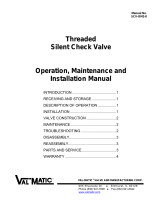
Service
f
Quality
f
commitment
Tel: 910-735-0000
s
Fax: 910-738-3848
s
s
www.titanfci.com
290 Corporate Drive
s
PO Box 7408
s
Lumberton, NC 28358
5
INSTALLATION, OPERATION,
AND MAINTENANCE
DUAL PLATE CHECK VALVE
CVDIOM0406
TITAN FLOW
CONTROL, INC.
MAINTENANCE: Continued...
Step 3:
Loosen the outlet side rst, never loosen the inlet side rst. Once
pressure has bee relived, loosen inlet side.
Step 4:
Remove Check Valve from the pipeline and inspect the internal
components for wear or damage. If replacement parts are required,
please constant Titan Flow Control for repair recommendations.
SPARE PARTS LIST:
For the bill of materials and spare parts listing of each Globe
Style Check Valve, please refer to the corresponding Engineering
Specication Submittal Sheet.
Trouble Shooting:
Leakage:
Periodic inspections for leakage should be performed. If leakage
is present, check the ange gasket and ange bolt torque. In some
situations, it may be necessary to isolate the Check Valve by shutting
off upstream and downstream valves. Then remove the Check Valve
and inspect the seating surfaces for damage.
When removing the Check Valve for inspection, please follow
the removal instructions presented in this manual. Always relieve
pressure from both sides of the Check Valve before inspection.
Vibration:
Verify that ow rate is within acceptable ranges (5 ft./sec. to 10
ft./sec.). Additionally, verify that the Check Valve is 5 to 10 pipe
diameters from any turbulence producing devices (elbows, pumps,
tees, expansions, reductions, and swages).
Slamming:
Remove Check Valve from piping system and inspect the spring.
Verify that the spring is providing the proper tension.
Restricted Flow:
If ow is halted at the Check Valve, verify that the ow direction
arrow (casted into the side of the body or printed on the nameplate)
is pointing in the direction of the ow.
WARRANTY:
Seller warrants each of the products and parts sold
hereunder, under normal use of service, and subject to
user’s compliance with any operating instructions and
other directions given by seller, to be free from defects
in materials or workmanship for a period of one year
from date of shipment from seller’s plant. Seller’s liability,
under this warranty, shall be limited to, at the seller’s
option, to repairing or replacing any such defective product
FOB seller’s plant in Lumberton, NC, and reimbursing
purchaser for shipping costs, subject to the following:
(1) Timely receipt of purchaser’s written notice that such
products are defective. (2) Seller’s written authorization
to purchaser for the return of such products, (3) the return
of such products to seller with shipping charges prepaid
and (4) seller’s inspection of and conrmation that such
products are defective in materials or workmanship. If
seller’s inspection shows that the products returned are
defective due to dirt, rust or any foreign material not
attributable to seller: improper usage, over tightening
on threads, abuse or incorrect assembly in the eld, or
other cause not due to seller’s improper manufacture,
seller will, subject to purchaser’s written authorization,
repair or replace such products at cost. Seller’s factory
inspection and testing reports will be made available to
purchaser upon request.
THIS WARRANTY IS IN LIEU OF ANY OTHER
WARRANTIES, EXPRESS OR IMPLIED, INCLUDING
ANY IMPLIED WARRANTY OF FITNESS OR
MERCHANTABILITY. SELLER SHALL NOT BE LIABLE FOR
ANY SPECIAL, INCIDENTAL, OR CONSEQUENTIAL
DAMAGES. NO REPRESENTATIVE OR SELLER HAS
AUTHORITY TO MAKE ANY REPRESENTATIONS OR
WARRANTIES, EXCEPT AS STATED HEREIN.







